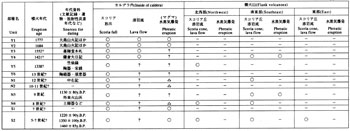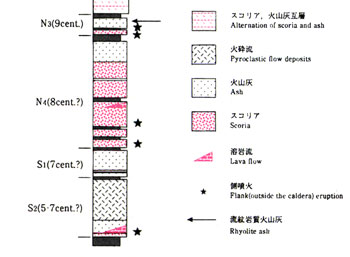Izu-Oshima Volcano
1: Introduction / Topography of Izu-Oshima
2: Geology of Izu-Oshima Volcano
3: Rocks of Izu-Oshima Volcano
4: Historical outline of Izu-Oshima Volcano after the formation of caldera
5: Activities after 19th century
6: Monitoring / Points to be watched for disaster prevention
7: References
![]() PREV
PREV ![]() NEXT
NEXT
Historical outline of Izu-Oshima Volcano after the formation of caldera
In syn- and post-caldera volcano, twelve large eruptions accompanied with more than several hundred million tons of ejecta are identified ( ![]() Table 2 and
Table 2 and ![]() Fig. 4 ). Averaged intervals of eruptions are 100 to 150 years. Those eruptions are one order larger than those after the middle of 19th century ( amounts of ejecta less than several tens of million tons ). The eruptions started with scoria falls from large-scale lava fountains at the summit, followed by lava flows, and then ash falls. Ash fall deposits near the summit are transitional to pyroclastic flows, and interpreted as representing explosive phreatic ( phreatomagmatic ) stage of pit crater formation accompanying retreating magma. In some cases, eolian deposits suggesting dormant periods are interbedded in fall deposits. The dormant periods may be amounting several to several tens of years. Also within a single deposit, products from different craters are identified in rare cases.
Fig. 4 ). Averaged intervals of eruptions are 100 to 150 years. Those eruptions are one order larger than those after the middle of 19th century ( amounts of ejecta less than several tens of million tons ). The eruptions started with scoria falls from large-scale lava fountains at the summit, followed by lava flows, and then ash falls. Ash fall deposits near the summit are transitional to pyroclastic flows, and interpreted as representing explosive phreatic ( phreatomagmatic ) stage of pit crater formation accompanying retreating magma. In some cases, eolian deposits suggesting dormant periods are interbedded in fall deposits. The dormant periods may be amounting several to several tens of years. Also within a single deposit, products from different craters are identified in rare cases.
Deposition of S2 member ( 5th to 7th century? ): The eruption which deposited S2 commenced as ejection of scoria from the summit followed by fissure eruptions from several locations within the island. Then a large-scale phreatic explosion at the summit followed ejecting head-sized cinders 2 - 3 km away from the crater. The pyroclastic flow covered almost all the island. The age of S2 is estimated to be between 1,500 and 1,300 yBP with carbon isotope data.
Thin scoria fall deposit and well-bedded lithic tuff bed are recognized between S2 and S1 in a small area of eastern island. It is named S'.
Deposition of S1 member ( 7th century? ): Scoria fall erupted from the summit gradually changed to pisolite-bearing fine-grained ash fall deposits originated from phreatic explosion. The scale of the eruption seems to be smaller than that of S2.
Deposition of N4 member ( 8th century? ): N4 member consists of thick scoria fall deposits and overlying fine-grained well-bedded ash bed. The scoria fall deposits are 2 to 3 m thick in the eastern island. They are interbedded with thin eolian deposits and ash fall deposits. Six scoria fall beds are identified. Based on the isopach data of scoria beds and distribution of parasitic volcanoes, those scoria beds were interpreted to have derived from different vents with short intervals in between ( several years to just over ten years ). The identified vents are distributed in the summit area, SW edge of caldera, and western flank. From the crater of the western flank, a lava flow came down to the back of where the Volcano Museum in Motomachi currently stands. Also a scoria cone ( Matsu-no-Kubo ), on the southern flank of the volcano, is identified to belong to N4 activity stage.
Deposition of N3 member ( 9th century ): The sequence starts from scoria fall deposits at the bottom overlain by ash fall deposits. After the cessation of eruptions from the summit and SE flank, a fissure eruption commenced and N3 member deposited from this eruption. Habuminato and Suribachi crater NNE of the former were created as explosion craters at this stage. Cinders ejected from Habuminato crater were deposited up to a km away from the crater. Near the top of N3 member is found interbedded thin rhyolitic ash bed flown from Tenjosan eruption of Kozushima in A.D. 838 or Mukaiyama eruption of Niijima in A.D. 886, and from it the age of the N3 eruption is identified to be in 9th century.
Deposition of N2 member ( 10th or 11th century? ): N2 consists of well-bedded intercalation of scoria fall and fine-grained ash fall deposits from the summit. Scoria beds tend to be more abundant toward the base. Fine-grained ash fall may contain pisolite. Lava flows and parasitic volcanoes of this stage are not known.
Deposition of N1 member ( 12th century? ): Same with N2, this consists of intercalated scoria fall and fine-grained ash deposits from the summit. Volcanic pisolite may occur in ash beds. Two scoria cones accompanying with two small lava flows on the southern flank are estimated to have formed in N1 stage.
An unconformity is developed between N1 and Y6 members.
Deposition of Y6 member ( 13th century? ):The sequence starts from scoria fall deposits followed by fine-grained ash fall deposits both from the summit crater. No parasitic volcanoes or lava flows belonging to this stage are identified.
Deposition of Y5 member ( 13th century ( 1338? ) ):Two fissures on the NW flank erupted scoria and lava flows which reached sea near where Motomachi township stands now. This was followed by scoria and fine-grained ash eruption from the summit. The fact that fragments of ceramic wares belonging to Late Kamakura period were dug up from the soil near the top of Y6 member and that a record of eruption exists in an old document ( Chikusenroku ) for 1338 indicate that the eruption of Y5 took place in 1338.
Deposition of Y4 member ( 15th century (1421? ) ): Simultaneously with an eruption of scoria from the summit, a fissure extending about 4 km in NW-SE direction opened up on south flank and produced Take-no-hira scoria cone, and Oana and Koana craters. Lava flows from the fissure reached Sashikiji and Mabushi. At Imasaki the fissure reached the sea causing phreatomagmatic explosion followed by ejection of scoria and produced tuff ring. Also a lava flow from within the caldera overflowed from the northern edge of the caldera wall. Covering those above, fine-grained ash was ejected. In several old documents, descriptions of the eruption on May 5th 1421 exist, for example, ‘There was an eruption in Izu-Oshima. The sound was like thunder. Sea water boiled and many fish were dead', and from those records Y4 activity is correlated to this eruption.
Deposition of Y3 member ( 16th century ( 1552? ) ): Following scoria fall eruption from the summit crater, lava flow filled the caldera. It overflowed from NE edge of the caldera and reached sea at present day eastern Senzu and Oshima Park. Fine-grained ash bed overlies lava. On an old wooden talisman dedicated to a Bhechadjaguru temple in Motomachi seems to have a record of this eruption.
Deposition of Y2 member ( 1684 - 1690 ): On March 29th 1684 ( Gregorian calendar ) an eruption started from the summit crater with lava fountain and ejection of scoria. By middle April, lava flow reached the eastern sea and formed lava flow fan of Cape Naganezaki. The ash fall continued until the following year with its thickness reaching 25 - 100 cm. Small-scale eruptions continued intermittently for another seven years until 1690.
Deposition of Y1 member ( 1777 - 92, the large An-ei eruption ): On the evening of August 31st 1777 ( Gregorian calendar ), an eruption commenced at the summit crater with lava fountains and scoria ejection. On April 19th 1778, lava flows from NW foot of Mt. Miharayama flowed down to NE direction. At the crater pahoehoe lava dome was formed. After this the volcano kept quiet for a while, but on November 6th resumed its activity with violent thundering sound and vibration and the lava flow reached present day highway overflowing SW wall of the caldera. On November 14th and possibly on 15th, lava flowed down to NE direction reaching the sea near Oshima Park. Another rather violent activity occurred in mid December. After those, several ash falls were recorded in 1783 - 86, and 1789. The activity ceased in 1792. The thickness of the ash fall was up to 1.2 to 1.5 m.

